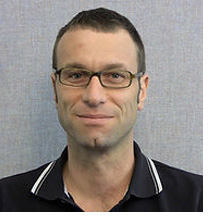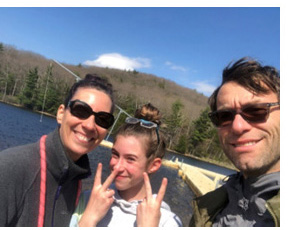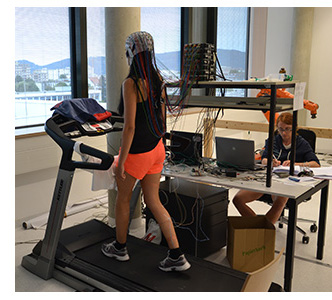The EEGLAB News #16
 Pierfilippo De Sanctis, Ph.D.
Pierfilippo De Sanctis, Ph.D.
Assistant Professor, Department of Pediatrics and Neurology
Assistant Professor, The Saul R. Korey Department of Neurology
Project Director, Cognitive Aging & Research
Albert Einstein College of Medicine
 Imagine walking on a treadmill in a darkened room, while lights are projected onto the front wall, and simultaneously being asked to perform cognitive tasks. What would be happening in your brain? That is what Dr. Pierfilippo De Sanctis and colleagues in the Division of Cognitive and Motor Aging (DCMA) and the Cognitive Neurophysiology Laboratory (CNL) at Albert Einstein College of Medicine aim to find out. Dr. De Sanctis is interested in how normal and pathological aging affect cognition and locomotion. He is especially interested in studying brain function when individuals divide their attention across two or more tasks while walking. He and his team have validated a novel Mobile Brain-Body Imaging (MoBI) system for parallel and integrated recordings of neurophysiological and 3D body kinematic data while participants are performing complex gait tasks. (Photo: Novel MoBI system)
Imagine walking on a treadmill in a darkened room, while lights are projected onto the front wall, and simultaneously being asked to perform cognitive tasks. What would be happening in your brain? That is what Dr. Pierfilippo De Sanctis and colleagues in the Division of Cognitive and Motor Aging (DCMA) and the Cognitive Neurophysiology Laboratory (CNL) at Albert Einstein College of Medicine aim to find out. Dr. De Sanctis is interested in how normal and pathological aging affect cognition and locomotion. He is especially interested in studying brain function when individuals divide their attention across two or more tasks while walking. He and his team have validated a novel Mobile Brain-Body Imaging (MoBI) system for parallel and integrated recordings of neurophysiological and 3D body kinematic data while participants are performing complex gait tasks. (Photo: Novel MoBI system)
During our everyday lives, we continuously process sensory and cognitive events while engaged in motor activities such as walking. An example of this is when we walk down the street, trying to avoid potholes and other obstacles, while contemplating what to make for dinner. However, little research has been done to study what happens in our brains when we divide our attention across two or more tasks during such mobile actions, especially for people who have neurological disorders. This is largely due to difficulties observing brain processes during walking. Dr. De Sanctis and his team have developed their novel MoBI system to mimic walking in a complex environment. The DCMA/CNL teams ultimately hope to better understand sensory-motor and cognitive impairments, and the costs associated with performing two or more tasks at the same time, in order to enhance mobility in individuals of advanced age or with neurological disorders.
Dr. De Sanctis answers some questions to shed light on his fascinating research:
Can you explain your research?
Most neuroimaging research on dementia is focused on how cognitive decline eventually leads to difficulties in complex everyday functional abilities such as shopping, finance, and more basic activities such as self-care and mobility. Less effort is spent on directly studying the neural underpinnings of everyday function, even though that is the central diagnosis feature of dementia. Hence, I am focused on what neurophysiological signatures of everyday function can add to better characterize dementia. EEG-based Mobile Brain Body Imaging is perfectly suited to address these questions as it allows imaging brain-body relationships while individuals engage in everyday activities.
How did you first become interested in your field?
My first idea was to become a musician. I love the music by Johann Sebastian Bach, and he composed quite a bit for the lute/guitar, which is my instrument of choice. That did not work out. I turned to Psychology and more specifically to the brain, mostly because it is such a mysterious and fascinating matter.
 Where were you born and raised?
Where were you born and raised?
I was born in Nurenberg Germany. Most of my time I spend in Uberlingen, a little town at a beautiful lake that borders Germany, Switzerland, and Austria. I went to Berlin Humboldt University of Berlin for my PhD in Clinical and Cognitive Neuroscience (1997-2001) and finally arrived in NYC for my post-doc. I live with Virginia (wife), Olivia (daughter), and Abby (dog) in Kent Connecticut about an hour north from the Bronx, where I work at the Albert Einstein College of Medicine. (Photo: Dr. De Sanctis with his wife Virginia and daughter Olivia)
How did you find out about the Swartz Center for Computational Neuroscience (SCCN)?
I met Scott Makeig for the first time in Berlin when he came to present at the Department of Biological Psychology at Humboldt University around 2000. It was the time when most people in our field were excited about fMRI, and it felt like being on the wrong track doing EEG. And here was Scott Makeig publishing in Science using EEG! It was very inspiring.
 During a visit to the SCCN in 2015, I reached out to Scott asking for guidance on design and analysis of MoBI data and he introduced me to Johanna Wagner. Johanna was so kind. She set aside a bunch of hours every day for a week to help my set up an analysis pipeline using EEGLAB, ICA, and time-frequency analysis. We analyzed the best part of a full data set and it felt like the Tour De France to me, with Johanna being the person to catch at the very front. Johanna was awesome! (Photo: Dr. Wagner monitoring one of her EEG gait adaptation experiments.)
During a visit to the SCCN in 2015, I reached out to Scott asking for guidance on design and analysis of MoBI data and he introduced me to Johanna Wagner. Johanna was so kind. She set aside a bunch of hours every day for a week to help my set up an analysis pipeline using EEGLAB, ICA, and time-frequency analysis. We analyzed the best part of a full data set and it felt like the Tour De France to me, with Johanna being the person to catch at the very front. Johanna was awesome! (Photo: Dr. Wagner monitoring one of her EEG gait adaptation experiments.)
How did you begin your work with Mobile Brain/Body Imaging (MoBI)?
I started working with MoBI in 2010 together with Dr. Foxe and Dr. Molholm, who were directing the Cognitive Neurophysiology Laboratory at Einstein at that time (Director of the CNL is currently Dr. Molholm). We were interested in designing complex gait tasks using MoBI to study mobility in aging. For example, we immerse individuals into a large-scale visual flow field designed to destabilize posture. We measure changes in gait pattern and gait-related EEG activity in response to such visual perturbation with a focus on aging. Because gait relies on motor and cognitive processes these mobility stress tests allow for early distinction of individuals with cognitive decline. There is a long tradition of aging research at the Albert Einstein College of Medicine using complex gait tasks to characterize early stages of cognitive decline and dementia. Dr. Verghese, mentor and close collaborator of mine, was among the first to establish changes in gait and mobility as an early feature of dementia and other adverse outcomes.
How did you find out about EEGLAB? And how do you combine the use of EEGLAB with other tools?
I found out about EEGLAB during my PhD. EEGLAB makes complex analysis procedures accessible to students of all backgrounds. That is wonderful! I use EEGLAB in combination with OptiTrack (motion capture and 3D tracking system) and Virtual Reality to study brain-behavior relationships in real and virtual space, addressing questions about multitasking and spatial navigation in healthy and pathological aging.
What are some of the challenges in the field?
The biggest challenge for me as a scientist is to keep a balance between writing, thinking, reading, and data analysis. It is so easy to get lost in data analysis and just spend too much time in the data cloud.
Recent publications
- De Sanctis P, Wagner J, Molholm S, Foxe JJ, Blumen HM, Horsthuis DJ. Neural signature of mobility-related everyday function in older adults at-risk of cognitive impairment. Neurobiol Aging. 2023 Feb;122:1-11. doi: 10.1016/j.neurobiolaging.2022.11.005. Epub 2022 Nov 9. PMID: 36463848.
- Verghese J, De Sanctis P, Ayers E. Everyday function profiles in prodromal stages of MCI: Prospective cohort study. Alzheimers Dement. 2023 Feb;19(2):498-506. doi: 10.1002/alz.12681. Epub 2022 Apr 26. PMID: 35472732; PMCID: PMC9596617.
- De Sanctis P, Solis-Escalante T, Seeber M, Wagner J, Ferris DP, Gramann K. Time to move: Brain dynamics underlying natural action and cognition. Eur J Neurosci. 2021 Dec;54(12):8075-8080. doi: 10.1111/ejn.15562. PMID: 34904290.
R. Weistrop, August 2023